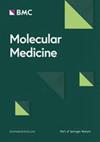The plasma proteome differentiates the multisystem inflammatory syndrome in children (MIS-C) from children with SARS-CoV-2 negative sepsis
IF 6
2区 医学
Q1 BIOCHEMISTRY & MOLECULAR BIOLOGY
引用次数: 0
Abstract
The Multi-System Inflammatory Syndrome in Children (MIS-C) can develop several weeks after SARS-CoV-2 infection and requires a distinct treatment protocol. Distinguishing MIS-C from SARS-CoV-2 negative sepsis (SCNS) patients is important to quickly institute the correct therapies. We performed targeted proteomics and machine learning analysis to identify novel plasma proteins of MIS-C for early disease recognition. A case-control study comparing the expression of 2,870 unique blood proteins in MIS-C versus SCNS patients, measured using proximity extension assays. The 2,870 proteins were reduced in number with either feature selection alone or with a prior COMBAT-Seq batch effect adjustment. The leading proteins were correlated with demographic and clinical variables. Organ system and cell type expression patterns were analyzed with Natural Language Processing (NLP). The cohorts were well-balanced for age and sex. Of the 2,870 unique blood proteins, 58 proteins were identified with feature selection (FDR-adjusted P < 0.005, P < 0.0001; accuracy = 0.96, AUC = 1.00, F1 = 0.95), and 15 proteins were identified with a COMBAT-Seq batch effect adjusted feature selection (FDR-adjusted P < 0.05, P < 0.0001; accuracy = 0.92, AUC = 1.00, F1 = 0.89). All of the latter 15 proteins were present in the former 58-protein model. Several proteins were correlated with illness severity scores, length of stay, and interventions (LTA4H, PTN, PPBP, and EGF; P < 0.001). NLP analysis highlighted the multi-system nature of MIS-C, with the 58-protein set expressed in all organ systems; the highest levels of expression were found in the digestive system. The cell types most involved included leukocytes not yet determined, lymphocytes, macrophages, and platelets. The plasma proteome of MIS-C patients was distinct from that of SCNS. The key proteins demonstrated expression in all organ systems and most cell types. The unique proteomic signature identified in MIS-C patients could aid future diagnostic and therapeutic advancements, as well as predict hospital length of stays, interventions, and mortality risks.血浆蛋白质组将儿童多系统炎症综合征(MIS-C)与 SARS-CoV-2 阴性败血症患儿区分开来
儿童多系统炎症综合征(MIS-C)可在感染 SARS-CoV-2 后数周出现,需要采用不同的治疗方案。将儿童多系统炎症综合征与 SARS-CoV-2 阴性败血症(SCNS)患者区分开来,对于迅速采用正确的疗法非常重要。我们进行了靶向蛋白质组学和机器学习分析,以确定 MIS-C 的新型血浆蛋白,用于早期疾病识别。一项病例对照研究比较了 MIS-C 和 SCNS 患者中 2870 种独特血液蛋白的表达,采用的是接近延伸测定法。通过单独的特征选择或事先的 COMBAT-Seq 批次效应调整,减少了 2870 个蛋白质的数量。主要蛋白质与人口统计学和临床变量相关。利用自然语言处理(NLP)技术分析了器官系统和细胞类型的表达模式。队列的年龄和性别非常均衡。在 2,870 个独特的血液蛋白质中,有 58 个蛋白质是通过特征选择鉴定的(FDR 调整后 P < 0.005,P < 0.0001;准确率 = 0.96,AUC = 1.00,F1 = 0.95),15 个蛋白质是通过 COMBAT-Seq 批次效应调整特征选择鉴定的(FDR 调整后 P < 0.05,P < 0.0001;准确率 = 0.92,AUC = 1.00,F1 = 0.89)。后 15 个蛋白质全部出现在前一个 58 蛋白模型中。一些蛋白质与疾病严重程度评分、住院时间和干预措施相关(LTA4H、PTN、PPBP 和 EGF;P <0.001)。NLP 分析强调了 MIS-C 的多系统性,58 个蛋白质集在所有器官系统中都有表达;消化系统的表达水平最高。涉及最多的细胞类型包括尚未确定的白细胞、淋巴细胞、巨噬细胞和血小板。MIS-C 患者的血浆蛋白质组与 SCNS 患者的不同。关键蛋白在所有器官系统和大多数细胞类型中均有表达。在 MIS-C 患者中发现的独特蛋白质组特征有助于未来诊断和治疗的发展,还能预测住院时间、干预措施和死亡风险。
本文章由计算机程序翻译,如有差异,请以英文原文为准。
求助全文
约1分钟内获得全文
求助全文
来源期刊

Molecular Medicine
医学-生化与分子生物学
CiteScore
8.60
自引率
0.00%
发文量
137
审稿时长
1 months
期刊介绍:
Molecular Medicine is an open access journal that focuses on publishing recent findings related to disease pathogenesis at the molecular or physiological level. These insights can potentially contribute to the development of specific tools for disease diagnosis, treatment, or prevention. The journal considers manuscripts that present material pertinent to the genetic, molecular, or cellular underpinnings of critical physiological or disease processes. Submissions to Molecular Medicine are expected to elucidate the broader implications of the research findings for human disease and medicine in a manner that is accessible to a wide audience.
文献相关原料
| 公司名称 | 产品信息 | 采购帮参考价格 |
|---|
 求助内容:
求助内容: 应助结果提醒方式:
应助结果提醒方式:


